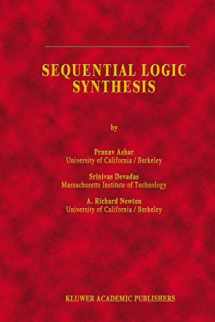
Sequential Logic Synthesis (The Springer International Series in Engineering and Computer Science)
ISBN-13:
9781461366133
ISBN-10:
1461366135
Edition:
Softcover reprint of the original 1st ed. 1992
Author:
A. Richard Newton, Pranav Ashar, S. Devadas
Publication date:
2012
Publisher:
Springer
Format:
Paperback
248 pages
FREE US shipping
Book details
ISBN-13:
9781461366133
ISBN-10:
1461366135
Edition:
Softcover reprint of the original 1st ed. 1992
Author:
A. Richard Newton, Pranav Ashar, S. Devadas
Publication date:
2012
Publisher:
Springer
Format:
Paperback
248 pages
Summary
Sequential Logic Synthesis (The Springer International Series in Engineering and Computer Science) (ISBN-13: 9781461366133 and ISBN-10: 1461366135), written by authors
A. Richard Newton, Pranav Ashar, S. Devadas, was published by Springer in 2012.
With an overall rating of 3.8 stars, it's a notable title among other
books. You can easily purchase or rent Sequential Logic Synthesis (The Springer International Series in Engineering and Computer Science) (Paperback) from BooksRun,
along with many other new and used
books
and textbooks.
And, if you're looking to sell your copy, our current buyback offer is $0.3.
Description
3. 2 Input Encoding Targeting Two-Level Logic . . . . . . . . 27 3. 2. 1 One-Hot Coding and Multiple-Valued Minimization 28 3. 2. 2 Input Constraints and Face Embedding 30 3. 3 Satisfying Encoding Constraints . . . . . . . 32 3. 3. 1 Definitions . . . . . . . . . . . . . . . 32 3. 3. 2 Column-Based Constraint Satisfaction 33 3. 3. 3 Row-Based Constraint Satisfaction . . 37 3. 3. 4 Constraint Satisfaction Using Dichotomies . 38 3. 3. 5 Simulated Annealing for Constraint Satisfaction 41 3. 4 Input Encoding Targeting Multilevel Logic. . 43 3. 4. 1 Kernels and Kernel Intersections . . . 44 3. 4. 2 Kernels and Multiple-Valued Variables 46 3. 4. 3 Multiple-Valued Factorization. . . . . 48 3. 4. 4 Size Estimation in Algebraic Decomposition . 53 3. 4. 5 The Encoding Step . 54 3. 5 Conclusion . . . . . . . . . 55 4 Encoding of Symbolic Outputs 57 4. 1 Heuristic Output Encoding Targeting Two-Level Logic. 59 4. 1. 1 Dominance Relations. . . . . . . . . . . . . . . . 59 4. 1. 2 Output Encoding by the Derivation of Dominance Relations . . . . . . . . . . . . . . . . . . . . . 60 . . 4. 1. 3 Heuristics to Minimize the Number of Encoding Bits . . . . . . . . . . . . 64 4. 1. 4 Disjunctive Relationships . . . . . . . . . . . 65 4. 1. 5 Summary . . . . . . . . . . . . . . . . . . 66 . . 4. 2 Exact Output Encoding Targeting Two-Level Logic. 66 4. 2. 1 Generation of Generalized Prime Implicants . 68 4. 2. 2 Selecting a Minimum Encodeable Cover . . . 68 4. 2. 3 Dominance and Disjunctive Relationships to S- isfy Constraints . . . . . . . . . . . 70 4. 2. 4 Constructing the Optimized Cover 73 4. 2. 5 Correctness of the Procedure . . 73 4. 2. 6 Multiple Symbolic Outputs . . .


We would LOVE it if you could help us and other readers by reviewing the book
Book review

Congratulations! We have received your book review.
{user}
{createdAt}
by {truncated_author}


